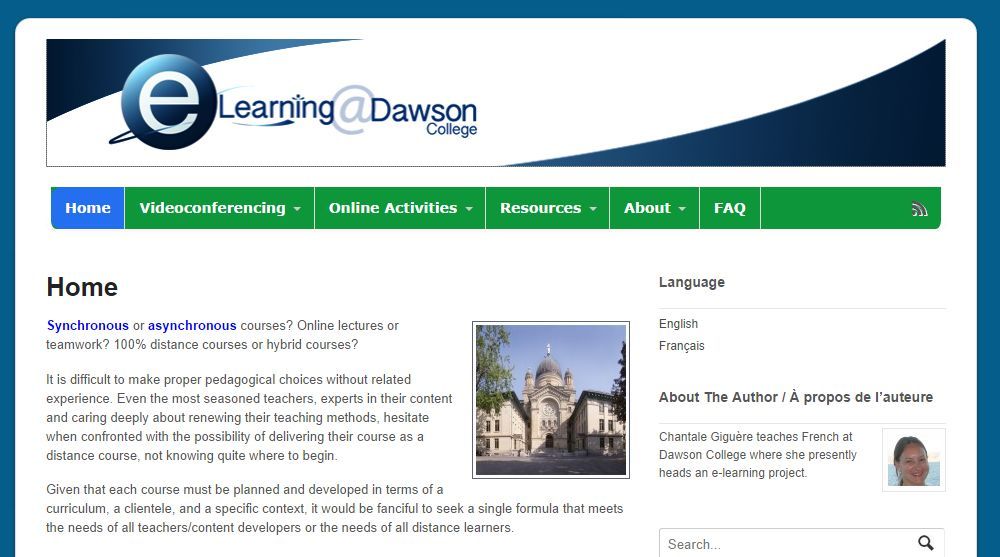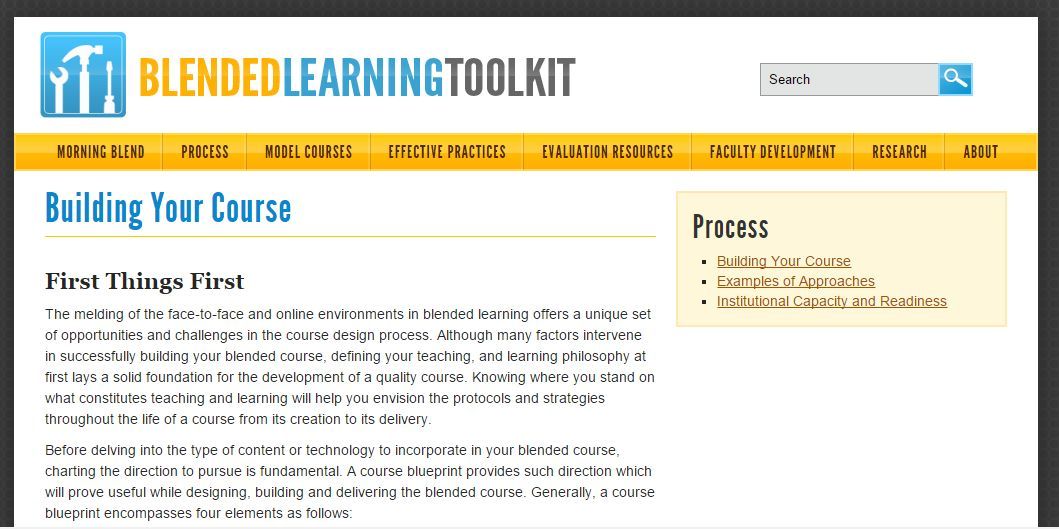eLearning@Dawson College
Should eLearning@Dawson be the subject of an article or be considered a digital tool? I first got wind of the concept when I interviewed Chantale Giguère for a real-life story in Profweb. The story was largely a listing of the many features that she had incorporated into her courses. Although we didn’t specifically mention the idea of creating an online site for teachers using eLearning, the contents of her story reflected her interests in transmitting what she had learned in developing her own virtual pedagogy to other teachers. eLearning@Dawson is in many ways a more developed expression of the interests that Chantale described in her Profweb article, and I feel, speaks to her general motivation to give teachers a helping hand with technology.
eLearning@Dawson is in many ways an extension of Chantale’s Profweb article, and I feel, speaks to her motivation to give teachers a helping hand.
eLearning@Dawson College – a digital tool
eLearning@Dawson was developed for teachers who would like to create their first online or blended course. This process, supported by the Director General, the Academic Dean and the Dawson College Office of Instructional Development, started with a consultation with teachers from different departments who had already taught online. Ryan Moon of Cégep à distance was present during the consultation with teachers to discuss their needs, and Rafael Scapin, Dawson’s ITRep, gave Chantale training about WordPress and supported her technically in her development of the site. From its conception, the site is an illustration of the intertwining between administration support and successful eLearning. As well, this resource is truly a tool for the entire Quebec college network; it’s bilingual and speaks to the college context.
Let’s take a look at how the site could be used by a teacher looking to develop an online or blended course or to modify an existing course.

The homepage of eLearning@Dawson
Like many websites (including Profweb), the main features are accessed through a horizontal bar near the top of the page. As befitting its role for the site, on eLearning@Dawson, this bar is prominent. Clicking on three of the six options, videoconferencing, online activities and resources, displays a drop-down menu with numerous options.
The structure suggests a logical approach to developing an online course. The teacher who is looking to develop a hybrid or online course would probably have their first introduction to the site as an overview of the task that lies before them. Reading the text at the start of course development, could serve to alert teachers to decisions they must make and problems that they might encounter. The associated glossary and links to other glossaries also serves to give the beginner the vocabulary to ask questions.
Here are some examples of decisions that are discussed in the site:
- What is the proper medium or interaction tool for attaining each of the targeted objectives of the distance course?
- How will the course respond to the needs of students with different learning styles and maintain interest?
- How can the course make it possible for students to acquire skills that will enable them to work in a given activity sector or to discover new areas that might guide their career choice?
- Even before course start, how can the students be prepared for the new experience of distance learning, so as to avoid disappointment or procrastination?
As well, potential problems are presented, so that the teacher can begin to deal with them beforehand:
- Some difficulties, whether technical or pedagogical and involving both teachers and students, will always arise in the context of a distance course. These might be technical problems (Internet connection, configuring peripherals, etc.) or pedagogical problems (activities that are too lengthy, exercises that are too complex to be done online, etc.). In a classroom-presented course, the experienced teacher will know how to deal with problems by making some spontaneous changes in the lesson of the day so as to be able to continue the course without too much difficulty. Still, it might be more complicated to improvise online. It thus becomes necessary to plan for substitute activities and supplementary modes of communication in case of unexpected events.
- While planning an online course, you can avoid a lot of difficulties with proper planning and organization. Avoid confusion by posting the schedule of online sessions far ahead of time. At the beginning of each course, specifically state your objectives and expectations as well as the kind of activities you have planned.
- In order to respond to the needs of different learning styles and to maintain interest, you are wise to vary activities from one course to the next as well as within each lesson.
Furthermore, as the teacher planning an online or blended course continues through the site, they will encounter coherent references to other resources that they might find useful. An excellent example is in the section FAQ which explains where teachers at Dawson College can get help and advice from the infrastructure and administration of the college. For teachers, not at Dawson, this kind of information can inspire the reader to make appropriate inquiries in their own school. Beyond the Resources section, there are multiple references. For example, right at the start in the ‘Preparation’ topic under the category ‘Videoconferencing’, at the bottom of the article there is a reference to the resource Blended Learning Kit.

The links in eLearning@Dawson can refer the reader to a wealth of useful information produced for all types of online courses such as the Blended Learning Kit.
eLearning@Dawson – a check list
Once the teacher has developed a course, elearning@Dawson can again become useful. A review of the site once the parameters of the course are known can pinpoint possible problems before the course is taught, avoiding complications in the classroom. The site can also give teachers at the start of an eLearning project a more nuanced perspective to deal with problems that do arrive. Although there is little in eLearning@Dawson that isn’t available somewhere else, what is remarkable about this resource is that its information is in one handy location.
There is a lot of publicity online about e-learning and a lot of research and many websites that focus on business needs or university level needs in this field. That being said, I have not seen a lot of reflections or original content with a focus on cegep online learning/teaching. This is a unique resource, useful for some cegep teachers who consider teaching online but don’t know where to start to make it work. And the research recommended, which is different in the French and English editions, has been chosen specifically for cegep teacher issues.

